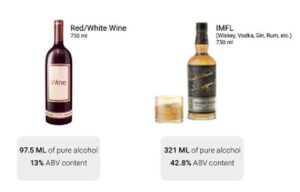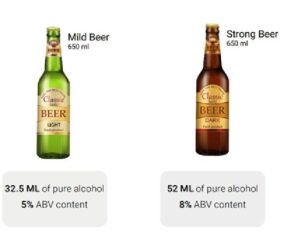Understanding safe alcohol consumption

Tushar Gandhi
On a leisurely Sunday evening, my friend and I contemplated the idea of uncorking a bottle of red wine. However, we found ourselves deliberating whether consuming the entire bottle would be excessive for the two of us. To be responsible in our consumption, we decided to embark on a calculation to ascertain the precise quantity of alcohol content within the bottle of wine, thereby enabling us to make a well-informed comparison with other alcoholic beverages such as beer and spirits.
After some calculations, we discovered that a 750 ml bottle of wine with approximately 14 per cent alcohol content (14 ml pure alcohol per 100 ml of wine) equates to 105 ml of pure alcohol. This means that each of us would consume 52.5 ml of pure alcohol. To put it in perspective, consuming a quarter (180 ml) of spirits like whiskey, vodka, rum, and IMFLs containing over 40 percent of pure alcohol translates to consuming 72 ml of pure alcohol. Similarly, a 650 ml bottle of regular and strong beer containing 5 and 8 percent alcohol respectively translates to consuming 32.5 ml and 54.4 ml of pure alcohol per bottle.
Pure alcohol content across beverages

Lack of Awareness on Safe Alcohol Consumption
In India, drinking patterns indicate that people often drink to ‘get intoxicated’ and engage in excessive and binge drinking. Unfortunately, there is a general lack of awareness regarding the actual amount of alcohol content in various beverages, and there is little understanding of what constitutes safe levels of consumption. A report by the National Institute of Mental Health and Neuro Sciences (NIMHANS) acknowledges this lack of awareness, which is fueled by confusing messages regarding alcohol use from health professionals and the media.
Guidelines on Safe Consumption
India is among the few countries that do not have specific guidelines on safe alcohol consumption or quantifiable limits of consumption. Instead, there is vague guidance rather than specific count, that leaves room for assumptions among consumers and health professionals. While measurements are not recommendations for how much one should drink, it would serve as a common reference for individuals to measure and moderate their intake.
Globally, there are guidelines based on the concept of a ‘Standard Drink,’ which provides a measurement of the amount of pure alcohol in various types of alcoholic beverages such as beer, wine, or spirits. In India as well, the Food Safety and Standards Authority of India (FSSAI) has provided a measurement for a standard drink. However, there is very little awareness about it.
Increasing Alcohol Consumption in India
Raising awareness about alcohol intake is crucial as India’s per capita alcohol consumption has been steadily increasing. According to a 2018 report by the World Health Organization (WHO), India’s per capita alcohol consumption rose from 2.4 liters in 2005 to 5.7 liters in 2016. This growth can be attributed to factors like changing demographics, improved living standards, higher incomes, shifting spending habits, and a growing culture of social drinking
The number of alcohol consumers increased from 219 million in 2005 to 293 million in 2018, with projections indicating it will reach 386 million by 2030. Notably, the upper middle-income group’s share in alcohol consumption has risen from 7 percent to 21 percent and is expected to reach 44 percent by 2030.
Additionally, the pandemic has influenced consumption patterns due to factors such as isolation, remote work arrangements, economic challenges, and heightened mental health awareness, as indicated in a U.S. report.
Promoting Responsible Alcohol Consumption
To promote responsible alcohol consumption and reduce per capita intake, both individuals and the government share the responsibility. At the individual level, it is crucial to be aware of one’s alcohol intake. However, the wide range of options available across beer, wine, and spirits, each with varying alcoholic content, can make it confusing. Additionally, in India’s price-sensitive economy, consumers often opt for cheaper options.
On part of the government, promoting awareness about the adverse effects of excessive alcohol consumption and encouraging moderation should be at the forefront of public health campaigns. The first step would be to create awareness about the pure alcohol content across different beverage types and establish guidelines for safe and permissible limits of consumption. The Ministry of Health and Family Welfare can consider creating a mobile app, that allows consumers to input the type and quantity of alcohol they’ve consumed, providing them with accurate information about the actual alcohol content. Furthermore, state governments could consider using taxation policies based on the alcoholic content of beverages as a tool for reducing alcohol consumption effectively. Such measures would be more beneficial than implementing a total ban, which often leads to issues like the sale of spurious liquor and smuggling.
The alcoholic beverage industry can contribute by displaying the amount of pure alcohol content on each bottle. Bars and restaurants can also help by printing the actual alcohol content for every drink they serve. These efforts would go a long way in creating awareness among consumers and promoting self-regulation.
In conclusion, the increasing per capita alcohol consumption and the preference for high-alcohol beverages in India underscore the pressing need for heightened awareness and well-defined guidelines for responsible drinking. Both individuals and the government share the responsibility in addressing this challenge effectively. By promoting awareness on alcoholic content across beverages, and implementing effective taxation policies, responsible alcohol consumption can be encouraged, leading to a reduction in overall intake. This multifaceted approach would ultimately contribute to safeguarding the health and well-being of the population.
Tushar Gandhi is Founder, Gateway Consulting, a research and public policy firm


